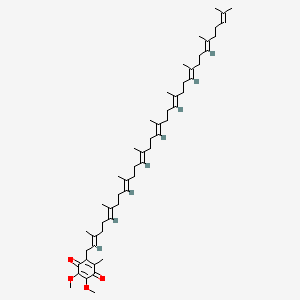| Authors | Title | Published | Journal | PubMed Link |
|---|---|---|---|---|
| pmid: | ||||
| Wang GS et al. | Dietary iron overload inhibits carbon tetrachloride-induced promotion in chemical hepatocarcinogenesis: effects on cell proliferation, apoptosis, and antioxidation. | 1999 | J. Hepatol. | pmid:10207812 |
| Navarro F et al. | Protective role of ubiquinone in vitamin E and selenium-deficient plasma membranes. | 1999 | Biofactors | pmid:10416028 |
| Lass A et al. | Mitochondrial coenzyme Q content and aging. | 1999 | Biofactors | pmid:10416032 |
| Stål P et al. | Effects of dietary iron overload on progression in chemical hepatocarcinogenesis. | 1999 | Liver | pmid:10459632 |
| Shi H et al. | 1-Methyl-4-phenyl-2,3-dihydropyridinium is transformed by ubiquinone to the selective nigrostriatal toxin 1-methyl-4-phenylpyridinium. | 1999 | FEBS Lett. | pmid:10567696 |
| Mattila P et al. | Comparison of in-line connected diode array and electrochemical detectors in the high-performance liquid chromatographic analysis of coenzymes Q(9) and Q(10) in food materials. | 2000 | J. Agric. Food Chem. | pmid:10775376 |
| Stefek M et al. | Effect of dietary supplementation with the pyridoindole antioxidant stobadine on antioxidant state and ultrastructure of diabetic rat myocardium. | 2000 | Acta Diabetol | pmid:11277310 |
| Battino M et al. | Coenzymes Q9 and Q10, vitamin E and peroxidation in rat synaptic and non-synaptic occipital cerebral cortex mitochondria during ageing. | 2001 | Biol. Chem. | pmid:11501757 |
| Palmeira CM et al. | Enhanced mitochondrial testicular antioxidant capacity in Goto-Kakizaki diabetic rats: role of coenzyme Q. | 2001 | Am. J. Physiol., Cell Physiol. | pmid:11502580 |
| Fraser PD et al. | Effect of the Cnr mutation on carotenoid formation during tomato fruit ripening. | 2001 | Phytochemistry | pmid:11524116 |
| Cabrini L et al. | Antioxidants and total peroxyl radical-trapping ability of olive and seed oils. | 2001 | J. Agric. Food Chem. | pmid:11743803 |
| Tatar M and Rand DM | Aging. Dietary advice on Q. | 2002 | Science | pmid:11778030 |
| Larsen PL and Clarke CF | Extension of life-span in Caenorhabditis elegans by a diet lacking coenzyme Q. | 2002 | Science | pmid:11778046 |
| Venditti P et al. | H2O2 production and response to stress conditions by mitochondrial fractions from rat liver. | 2002 | J. Bioenerg. Biomembr. | pmid:12018888 |
| Sul D and Kaneshiro ES | Pneumocystis carinii f. sp. carinii synthesizes de novo four homologs of ubiquinone. | 2001 Mar-Apr | J. Eukaryot. Microbiol. | pmid:12095106 |
| Muralikrishnan D et al. | Effect of MPTP on Dopamine metabolism in Ames dwarf mice. | 2002 | Neurochem. Res. | pmid:12199149 |
| Alarico S et al. | Rubritepida flocculans gen. nov., sp. nov., a new slightly thermophilic member of the alpha-1 subclass of the Proteobacteria. | 2002 | Syst. Appl. Microbiol. | pmid:12353873 |
| Niklowitz P et al. | Coenzyme Q10 in plasma and erythrocytes: comparison of antioxidant levels in healthy probands after oral supplementation and in patients suffering from sickle cell anemia. | 2002 | Clin. Chim. Acta | pmid:12417107 |
| Asencio C et al. | Silencing of ubiquinone biosynthesis genes extends life span in Caenorhabditis elegans. | 2003 | FASEB J. | pmid:12709403 |
Coenzyme Q9
Coenzyme q9 is a lipid of Prenol Lipids (PR) class. The involved functions are known as Diastasis, Phosphorylation and Cardiac function.
Cross Reference
Introduction
To understand associated biological information of Coenzyme Q9, we collected biological information of abnormalities, associated pathways, cellular/molecular locations, biological functions, related genes/proteins, lipids and common seen animal/experimental models with organized paragraphs from literatures.
What diseases are associated with Coenzyme Q9?
There are no associated biomedical information in the current reference collection.
No disease MeSH terms mapped to the current reference collection.
PubChem Associated disorders and diseases
What pathways are associated with Coenzyme Q9
There are no associated biomedical information in the current reference collection.
PubChem Biomolecular Interactions and Pathways
Link to PubChem Biomolecular Interactions and PathwaysWhat cellular locations are associated with Coenzyme Q9?
There are no associated biomedical information in the current reference collection.
What functions are associated with Coenzyme Q9?
Related references are published most in these journals:
| Function | Cross reference | Weighted score | Related literatures |
|---|
What lipids are associated with Coenzyme Q9?
There are no associated biomedical information in the current reference collection.
What genes are associated with Coenzyme Q9?
There are no associated biomedical information in the current reference collection.
What common seen animal models are associated with Coenzyme Q9?
There are no associated biomedical information in the current reference collection.
